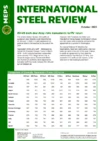US tariff threat hangs over North American steel sector
President Trump issued his first tariff threat shortly after being sworn in as the 47th President of the United States.
On the evening of January 20, the newly inaugurated president announced plans to impose a 25% tariff on all US imports from Mexico and Canada, starting on February 1. The following day, he proposed a 10% tariff on imports from China, citing each country’s role in the flow of fentanyl and illegal immigration into the US as the primary reasons for the potential measures. If implemented, these tariffs could have severe near-term consequences for the US steel sector and the wider economy.
- This article was first published in MEPS's International Steel Review. The monthly report provides subscribers with steel prices, indices, market commentary and forecasts from key global steel markets. Contact MEPS for details of how to subscribe.
Despite the announcement, there is considerable uncertainty about whether these tariffs will take effect on February 1. President Trump did not officially impose tariffs on Mexico, Canada, or China on his first day in office, as he had pledged to during his election campaign. Instead, he signed an "America First Trade Policy" memorandum, directing federal agencies to investigate and recommend actions to prioritise US interests in trade practices by April 1. Even if these tariffs do not come into effect on February 1, importers should prepare for higher tariffs and prices in 2025.
Potential Implications
China, Mexico, and Canada are the United States’ largest trading partners, accounting for a significant share of both imports and exports. Chinese imports are already subject to tariffs under Section 232 and 301 legislations. However, trade with Mexico and Canada is governed by the United States-Mexico-Canada Agreement (USMCA), which eliminates tariffs on most goods crossing North American borders. The implementation of the proposed 25% tariff would not only represent a potential violation of USMCA but would also have a significant effect on North American supply chains.
The Mexican and Canadian economies are heavily dependent on trade with the US. The US market accounts for over 75% of their total exports. Both countries have indicated they would respond to US tariffs with reciprocal measures. Canadian Prime Minister Justin Trudeau said that he supports the principle of dollar-for-dollar matching tariffs. Meanwhile, Mexican President Claudia Sheinbaum has emphasised cooperation on critical issues, including immigration.
For the US steel industry, Canada and Mexico are critical partners, ranking as the first and third largest exporters of steel to the US in 2024. Together, they account for 35% of all US steel imports, according to US Commerce Department data. Companies relying on flat steel products may be hit particularly hard, as Canada and Mexico supply 42% of all US flat product imports. China, already subject to substantial tariffs, accounts for less than 2% of all US steel imports.
Further US trade issues
While President Trump may delay implementing new trade defence measures that affect the supply and price of imported steel, he has signalled a broader use of tariffs in 2025. This plan could be realised after the April 1 deadline for his administration’s trade policy review.
The findings of an ongoing trade case could have further implications for steel imports from mid-2025. The US government is investigating potential antidumping and countervailing duties on the top 10 importers of corrosion-resistant (CORE) steel.
Other countries are also exploring trade defence measures. For instance, the European Commission is currently reviewing the quota-based import safeguard measures system to protect its steel industry. Options under consideration include increasing the tariff rate for imports exceeding quotas, with a decision expected by the end of March.

Source:
International Steel Review
The MEPS International Steel Review is an essential monthly publication, offering professional analysis and insight into carbon steel prices around the world.
Go to productRequest a free publication





